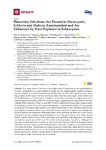Phaeoviral Infections Are Present in Macrocystis, Ecklonia and Undaria (Laminariales) and Are Influenced by Wave Exposure in Ectocarpales
| dc.contributor.author | McKeown, DA | |
| dc.contributor.author | Joanna L. Schroeder, JL | |
| dc.contributor.author | Stevens, K | |
| dc.contributor.author | Peters, AF | |
| dc.contributor.author | Sáez, CA | |
| dc.contributor.author | Park, J | |
| dc.contributor.author | Rothman, MD | |
| dc.contributor.author | Bolton, JJ | |
| dc.contributor.author | Brown, Murray | |
| dc.contributor.author | Schroeder, DC | |
| dc.date.accessioned | 2018-10-13T12:06:37Z | |
| dc.date.issued | 2018-08-05 | |
| dc.identifier.issn | 1999-4915 | |
| dc.identifier.issn | 1999-4915 | |
| dc.identifier.other | ARTN 410 | |
| dc.identifier.uri | http://hdl.handle.net/10026.1/12498 | |
| dc.description.abstract |
Two sister orders of the brown macroalgae (class Phaeophyceae), the morphologically complex Laminariales (commonly referred to as kelp) and the morphologically simple Ectocarpales are natural hosts for the dsDNA phaeoviruses (family Phycodnaviridae) that persist as proviruses in the genomes of their hosts. We have previously shown that the major capsid protein (MCP) and DNA polymerase concatenated gene phylogeny splits phaeoviruses into two subgroups, A and B (both infecting Ectocarpales), while MCP-based phylogeny suggests that the kelp phaeoviruses form a distinct third subgroup C. Here we used MCP to better understand the host range of phaeoviruses by screening a further 96 and 909 samples representing 11 and 3 species of kelp and Ectocarpales, respectively. Sporophyte kelp samples were collected from their various natural coastal habitats spanning five continents: Africa, Asia, Australia, Europe, and South America. Our phylogenetic analyses showed that while most of the kelp phaeoviruses, including one from Macrocystispyrifera, belonged to the previously designated subgroup C, new lineages of Phaeovirus in 3 kelp species, Ecklonia maxima, Ecklonia radiata, Undaria pinnatifida, grouped instead with subgroup A. In addition, we observed a prevalence of 26% and 63% in kelp and Ectocarpales, respectively. Although not common, multiple phaeoviral infections per individual were observed, with the Ectocarpales having both intra- and inter-subgroup phaeoviral infections. Only intra-subgroup phaeoviral infections were observed in kelp. Furthermore, prevalence of phaeoviral infections within the Ectocarpales is also linked to their exposure to waves. We conclude that phaeoviral infection is a widely occurring phenomenon in both lineages, and that phaeoviruses have diversified with their hosts at least since the divergence of the Laminariales and Ectocarpales. | |
| dc.format.extent | 410-410 | |
| dc.format.medium | Electronic | |
| dc.language | en | |
| dc.language.iso | en | |
| dc.publisher | MDPI | |
| dc.subject | phaeovirus | |
| dc.subject | Phycodnaviridae | |
| dc.subject | Ectocarpales | |
| dc.subject | kelp | |
| dc.subject | NCLDV | |
| dc.subject | prevalence | |
| dc.subject | phylogeny | |
| dc.subject | MCP | |
| dc.subject | latency | |
| dc.title | Phaeoviral Infections Are Present in Macrocystis, Ecklonia and Undaria (Laminariales) and Are Influenced by Wave Exposure in Ectocarpales | |
| dc.type | journal-article | |
| dc.type | Journal Article | |
| dc.type | Research Support, Non-U.S. Gov't | |
| plymouth.author-url | https://www.webofscience.com/api/gateway?GWVersion=2&SrcApp=PARTNER_APP&SrcAuth=LinksAMR&KeyUT=WOS:000443619600021&DestLinkType=FullRecord&DestApp=ALL_WOS&UsrCustomerID=11bb513d99f797142bcfeffcc58ea008 | |
| plymouth.issue | 8 | |
| plymouth.volume | 10 | |
| plymouth.publication-status | Published online | |
| plymouth.journal | Viruses | |
| dc.identifier.doi | 10.3390/v10080410 | |
| plymouth.organisational-group | /Plymouth | |
| plymouth.organisational-group | /Plymouth/Faculty of Science and Engineering | |
| plymouth.organisational-group | /Plymouth/REF 2021 Researchers by UoA | |
| plymouth.organisational-group | /Plymouth/REF 2021 Researchers by UoA/UoA06 Agriculture, Veterinary and Food Science | |
| plymouth.organisational-group | /Plymouth/Research Groups | |
| plymouth.organisational-group | /Plymouth/Research Groups/Marine Institute | |
| dc.publisher.place | Switzerland | |
| dcterms.dateAccepted | 2018-08-02 | |
| dc.rights.embargodate | 2019-1-11 | |
| dc.identifier.eissn | 1999-4915 | |
| dc.rights.embargoperiod | Not known | |
| rioxxterms.versionofrecord | 10.3390/v10080410 | |
| rioxxterms.licenseref.uri | http://www.rioxx.net/licenses/all-rights-reserved | |
| rioxxterms.licenseref.startdate | 2018-08-05 | |
| rioxxterms.type | Journal Article/Review |


